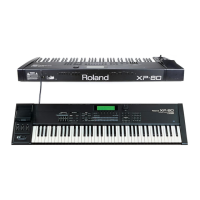®ÂØÒňΠXP-60/80 Supplemental Notes
© 1998 Roland Corporation U.S. XP-60/80 Advanced Sequencing Page 5 of 9
Groo
ve Quantize (continued)
4) Press F2 (Quantize) followed by F3 (Groove).
5) CURSOR to Target and use the VALUE DIAL to select “PTN 001.”
6) CURSOR to Measure and use the VALUE DIAL to select “1.”
7) CURSOR to For and use the VALUE DIAL to select “ALL.”
8) CURSOR to Channel and use the VALUE DIAL to select “ALL.”
9) CURSOR to Note Range and use the VALUE DIAL to select “C-1 - G9.”
10) CURSOR to Template Number and use the VALUE DIAL to select “PRE:001.”
11) Press PLAY. Use the VALUE DIAL to try different Groove Templates.
12) Press F6 (Execute) when you find the desired feel, then press EXIT.
Try the following Templates:
• Select 03: Late _S to delay the snare drum.
• Select 05: Late_K to delay the kick drum.
• Select 06: 16_Lshuf for a sixteenth note shuffle.
IV. Microscope Edit
The Microscope Edit function allows you to view and edit single MIDI events. This is unlike the Track Edit and
Quantize functions discussed above, which are used to edit large sections of a sequence. You can use
Microscope Edit to create a note, program change, or controller message. You can also use Microscope Edit to
fix a wrong note, change a volume setting for a Part, or erase, copy or move any MIDI event. Press F4 (Micro) to
display the following screen:
SEQ/Micro
Microscope Pattern 001
Fig. 1
3-01-000 >1 Note (C4) 60 OnV=127 Gt=192 OfV=64
048 2 Prog
Change
PC# = 64
072 16 Ctrl Change CC# = 7 (Volume) 110
084 16 Note (C#4) 61 100 15 64
087 16 Note (D4) 62 107 25 64
090 16 Note (D#4) 63 120 35 64
Create Erase Move Copy Place View
The above screen displays a lot of information. On the top line we can see that we are in Microscope Mode on
Pattern 001. Below this is the main section of the window that displays the actual data with each MIDI event on a
separate line. Reading from left to right for the first event, we can see that we are viewing Pattern 001 at 3-01-000
(measure 3, beat 1, clock beat 000). Next we see that this message is on MIDI channel 1 and that the message is
Note number 60 (C4). Finally, the Note On velocity (how hard the note was struck), the Gate Time (how long the
note was held down), as well as the Note Off velocity (how quickly the note was released) are displayed. The
Note On velocity (OnV) and Note Off velocity (OfV) have a range of 0-127. The Gate Time is set to 192, which is
equal to a half note (since the XP-60/80 uses 96 pulses per quarter note, 96 is equal to 1 quarter note so 192
equals 2 quarter notes or one half note). The next event is a Program Change message on MIDI channel 2 with a
value of 64. This occurs at 3-01-048. After that, we have a Volume message on MIDI channel 16 with a value of
110 occurring at 3-01-072.
Normally you will use the UP and DOWN CURSOR buttons to step through the events in Microscope Mode. You
can also use the BWD and FWD buttons as well as the locate function to go to a particular bar.
Change
Y
ou can easily change any event in Microscope Mode using the following procedure:
1) Use the UP and DOWN CURSOR buttons to locate the event you wish to edit.
2) Use the LEFT and RIGHT CURSOR buttons to select the parameter to be changed (MIDI channel, Note
number, Velocity, Gate time, etc.).
3) Use the VALUE DIAL to edit to the desired value.

